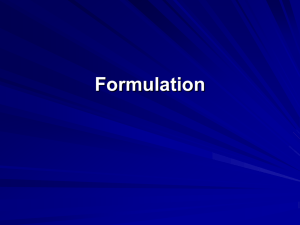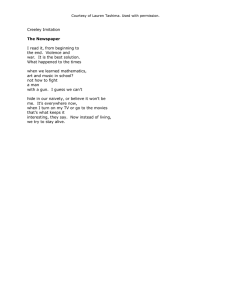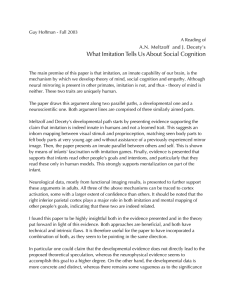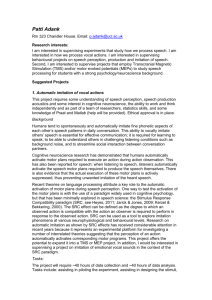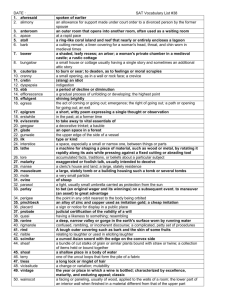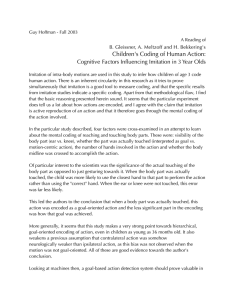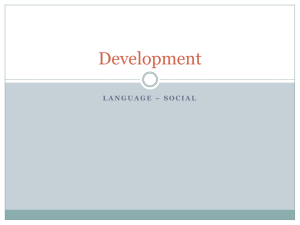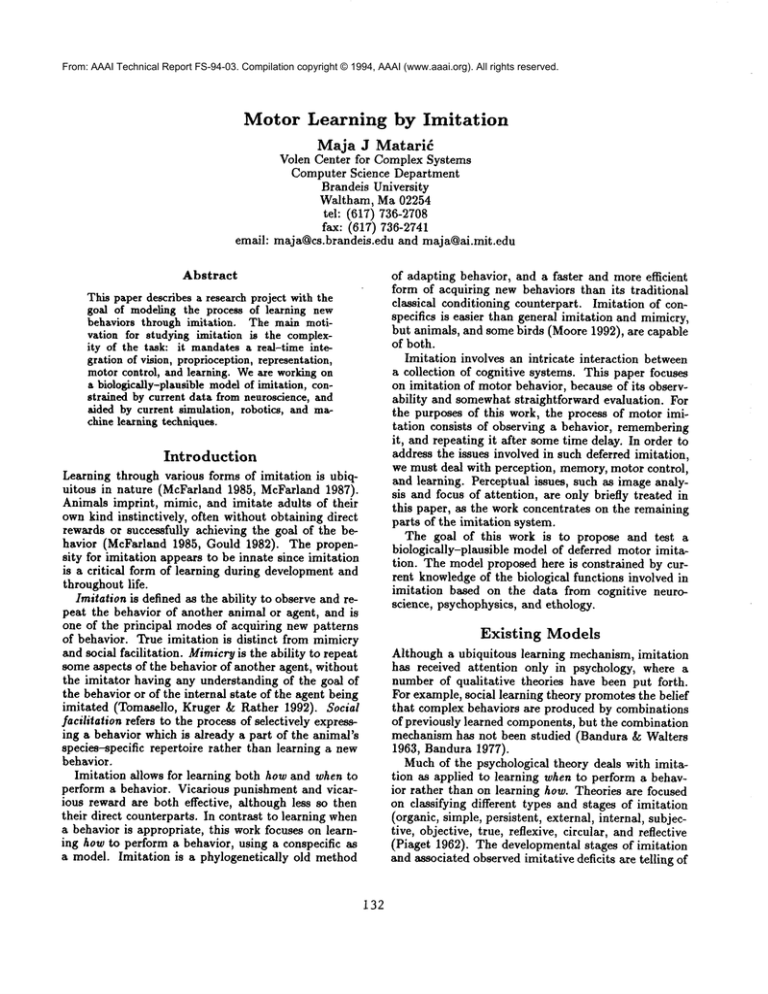
From: AAAI Technical Report FS-94-03. Compilation copyright © 1994, AAAI (www.aaai.org). All rights reserved.
Motor Learning
by Imitation
Maja J Matari~
Volen Center for Complex Systems
Computer Science Department
Brandeis University
Waltham, Ma 02254
tel: (617) 736-2708
fax: (617) 736-2741
emaih maja@cs.brandeis.edu and maja@ai.mit.edu
Abstract
of adapting behavior, and a faster and more efficient
form of acquiring new behaviors than its traditional
classical conditioning counterpart. Imitation of conspecifics is easier than general imitation and mimicry,
but animals, and some birds (Moore 1992), are capable
of both.
Imitation involves an intricate interaction between
a collection of cognitive systems. This paper focuses
on imitation of motor behavior, because of its observability and somewhat straightforward evaluation. For
the purposes of this work, the process of motor imitation consists of observing a behavior, remembering
it, and repeating it after sometime delay. In order to
address the issues involved in such deferred imitation,
we must deal with perception, memory, motor control,
and learning. Perceptual issues, such as image analysis and focus of attention, are only briefly treated in
this paper, as the work concentrates on the remaining
parts of the imitation system.
The goal of this work is to propose and test a
biologically-plausible
model of deferred motor imitation. The model proposed here is constrained by current knowledgeof the biological functions involved in
imitation based on the data from cognitive neuroscience, psychophysics, and ethology.
This paper describes a research project with the
goal of modeling the process of learning new
behaviors through imitation. The main motivation for studying imitation is the complexity of the task: it mandates a real-time integration of vision, proprioception, representation,
motorcontrol, and learning. Weare working on
a biologically-plausible modelof imitation, constrained by current data from neuroscience, and
aided by current simulation, robotics, and machine learning techniques.
Introduction
Learning through various forms of imitation is ubiquitous in nature (McFarland 1985, McFarland 1987).
Animals imprint, mimic, and imitate adults of their
ownkind instinctively, often without obtaining direct
rewards or successfully achieving the goal of the behavior (McFarland 1985, Gould 1982). The propensity for imitation appears to be innate since imitation
is a critical form of learning during development and
throughout life.
Imitation is defined as the ability to observe and repeat the behavior of another animal or agent, and is
one of the principal modes of acquiring new patterns
of behavior. "l~rue imitation is distinct from mimicry
and social facilitation. Mimicryis the ability to repeat
some aspects of the behavior of another agent, without
the imitator having any understanding of the goal of
the behavior or of the internal state of the agent being
imitated (Tomasello, Kruger & Rather 1992). Social
facilitation refers to the process of selectively expressing a behavior which is already a part of the animal’s
speci~ specific repertoire rather than learning a new
behavior.
Imitation allows for learning both how and when to
perform a behavior. Vicarious punishment and vicarious reward are both effective, although less so then
their direct counterparts. In contrast to learning when
a behavior is appropriate, this work focuses on learning how to perform a behavior, using a conspecific as
a model. Imitation is a phylogenetically old method
Existing
Models
Although a ubiquitous learning mechanism, imitation
has received attention only in psychology, where a
number of qualitative theories have been put forth.
For example, social learning theory promotes the belief
that complex behaviors are produced by combinations
of previously learned components, but the combination
mechanism has not been studied (Bandura & Waiters
1963, Bandura 1977).
Muchof the psychological theory deals with imitation as applied to learning when to perform a behavior rather than on learning how. Theories are focused
on classifying different types and stages of imitation
(organic, simple, persistent, external, internal, subjective, objective, true, reflexive, circular, and reflective
(Piaget 1962). The developmental stages of imitation
and associated observed imitative deficits are telling of
132
requirements for sophisticated imitation.
One such requirement is self-awareness. Self- and
other-awareness allows for representing the external
and internal state of others as distinct from one’s own,
i.e. to form mental models. Furthermore, it allows
it to distinguish the causes and effects of its ownand
others’ actions. While mental modeling is experimentally testable, it has not been conclusively confirmed in
other species (McFarland 1985). For example, chimps
are known to have some mental modeling capacities,
while monkey are shown to have none (Cheney & Seyfarth 1990, Cheney & Seyfarth 1991). Nonetheless,
both can engage in intricate behavior mimicry and apparent imitation.
The extent to which mental modeling is required for
motor imitation is questionable. It is feasible that an
animal need only have a model of what its actions look
like to itself, rather than engaging in the transformation of what its actions look like to an observer. The
model we propose accounts for this possibility.
Motor Control
and Learning
Imitation involves two types of learning. The first is
learning a specific sequence of actions, a new behavior. The second is learning the internal model of one’s
dynamics, improving the predictive mapping between
one’s actions and their consequences in the world.
Furthermore, motor imitation involves the use of
both allocentric and egocentric coordinates, as the observed behavior is in the former, but the imitation must
result in a correct orientation in the latter. The model
we are interested in pursuing focuses on imitation of
pootural and limb behaviors. In general, imitation of
meaningless movementsis more difficult than that of
meaningful (and thus familiar) ones.
Related
Data
With the exception of hand movementcopying, no neuropsychological data specific to imitation are available.
However, useful information can be found in developmental psychological literature,
where imitation has
explicitly been studied.
Behavioral psychology experiments provide additional evidence for dissociated memorysystems. For
example, curare-conditioning experiments in which animals are skeletally immobilized have been used to
showthat even in those conditions animals can acquire,
integrate, and subsequently utilize new behavior patterns (Bandura 1971).
That a motor representation is not necessary for remembering an observed behavior is intuitive.
Such
deferred imitation was experimentally confirmed even
in the case of infants whowere able to repeat behaviors observed a week before without having been given
a chance to repeat it immediately after observation
(Meltzoff 1988). Furthermore, Abravanel (1991)
scribes experimental data supporting a postulate that
immediate repetition of a motor task does not improve
133
Figure 1: An information processing diagram of the
imitation system.
retention. However, the test was applied to simple action sequences with external feedback (such as snapping two toy pieces together), which did not require
intricate calibration to succeed. From this data we
can postulate that simple sequences of motor actions,
which do not perceptively improve after a single physical trial, do not benefit from a procedural representation as they can be easily described declaratively. In
contrast, complex motor behaviors that are difficult to
semantically/symbolically represent benefit from physical trials and the resulting procedural learning. This
intuitive result can be tested with a variety of psychophysical experiments, some of which are described
in the next section.
At least one cause for improved performance with
older age is not directly related to higher development
of long-term memorysystems but is correlated with
the development of motor/action schemas (Abravanel
& Gingold 1985). An older individual is more likely
to have had previous experience with similar motor
actions and which it can apply to the new situation.
Intuitively, the more experienced the person, the less
of the motor behavior is truly "new."
The Model
Our model contains the following subsystems:
¯ a vision-based perceptual system,
¯ a pseudo-symbolic representation of the perceived
information,
¯ a system for translating the representation information into an egocentric reference frame,
¯ an implicit representation of motor actions,
¯ a system for communicating between the two representations,
¯ a system for generating sequences of actions.
The model represents the stream of information processing during the motor imitation task. Furthermore,
it postulates specific regions involved in the processing.
Figure 1 illustrates the model. It indicates the information transformation modules (indicated with boxes),
Wehave already conducted a series of eye-tracking
experiments with the goal of studying focus of attention while an individual is attending to a model performing a behavior that is to be later imitated. We
gathered data from over 20 individuals observing hand
and arm motions. Weare currently analyzing the data
and searching for differences in attention in subjects
with and without the intention to imitate.
Weare also studying the data for differences and
improvement in imitation of the same motor behavior
over multiple trials. Weexpect that while some simple or symbolically coded tasks do not behefit from
practice, largely proprioceptively-driven motor behavior heavily relies on it.
Weare also interested in studying the type and role
of internal representations for motor behaviors. The
author makes a strong claim in favor of intermediate
symbolic representations for manipulation tasks. The
presence of the representations is assumedto result in
better delayed repetition while the absence of such representations (due to imposed distracting mental tasks)
results in less accurate recall and imitation. Wepropose a set of experiments that address issues related to
those of Gerst (1971) and Abravanel (1991), but
additional controls and a direct focus on exploring the
role of practice and imagery in motor imitation.
It is critical that the behavior to be imitated is designed to be unfamiliar so as to eliminate as many
behavior-specific associations and representations the
subjects may be using as possible. Wepostulate that
the subjects encouraged to make symbolic descriptions
of the observed behavior are expected to generate artificial and arbitrary descriptions which, in contrast to
the results presented by Gerst (197’1), will serve to debilitate their recall.
information flow (indicated with directed arrows), and
specific processing regions (indicated with ovals).
The first information transformation (T1) computes
a transfer function form the input signal (in this case
assumed to be visual) into an internal representation.
Attention and context are used to modulate the transformation. Since we are interested in deferred imitation, we are including the transition from STMinto
some form of declarative LTMin T1.
The second information transformation (T2) occurs
when the agent imagines or intends to perform an imitative act. The first step involves a translation of the
behavior encoding in terms of allocentric coordinates
into a body-centered plan of motions, or at least into
the first body-centered step in the sequence.
The third information transformation (T3) occurs
when the agent begins to execute motor imitation. The
body-centered representation of movementsis translated into and mapped onto a collection of existing
motor schemas. The schemas are then translated into
explicit motor commandssent to the muscles.
Experimental
Environments
The proposed model will be tested in two types of experimental environments. A particular version of the
model will be implemented in a physical simulation for
testing the components and their interactions. Furthermore, a number of psychophysical experiments will
be performed to obtain additional constraints on the
model.
Simulation
Experiments
A functional version of the imitation model will be implemented in the form of a Lisp program and tested
on a physically-based simulation with human mechanics. The dynamics simulation was chosen because it
provides a potentially very complex dynamical system
in which to study motor imitation and learning. As
a simulation, the environment allows great flexibility
in terms of controls, numbers and specifics of the experiments. Most importantly, it allows for simulating
various lesions on the system in order to directly study
the implications of its organization. Finally, the simulation also provides more sophisticated dynamics than
most of the currently available robotic platforms.
The experimental testbed in which the simulation
runs consists of a graphically rendered human figure
with physically-based dynamics1. The figure has average humandimensions and mass distribution in order to ensure realistic inertial properties. The body is
Figure 2: A wire-frame representation of the body in
the physically-based simulator. The articulated joints
are marked with black discs.
Psychophysical
Experiments
This section describes some preliminary psychophysica] experiments for testing parts of the model and generating humandata for additional constraints.
1Aphysical simulation systemconsisting of the Creature
Library using SD/Fast, Legplot, and Anita, products of
Symbolic Dynamics,Inc.
134
articulated from the waist up, so as to match the human experiments 2. The articulated joints include the
waist, the shoulders, the elbows, the wrists, and the
neck. Figure 2 shows the wire-frame representation of
the body used in the experiments 3 Articulated joints
are marked with black discs.
The simulation uses two types of sensors: external
perception and internal proprioception. External sensing is necessarily simulated. It is designed to model
vision, and is capable of parsing an input of a moving
figure with identical mechanicsas the agent itself. This
is consistent with our humanexperiments in which the
subject views a model with roughly identical mechanics. Specifically, there is nothing in the modelbehavior
that cannot be directly translated into a sequence of
the observer’s actions. The topic of study is how this
translation occurs, and what systems are involved.
The internal proprioceptive sensors are located at all
of the articulated joints, and provide force and torque
feedback. In order to make the control problem more
realistic, the joints are controlled using a combination
of desired torque and position, where both values are
roughly specified and rely, at least in the initial stages,
on external feedback. Proprioception is important for
two key reasons. It provides the error signals to guide
the motor learning process which generates a better
internal model of the body’s dynamics. Additionally,
proprioception provides feedback that can be used to
guide focusing of attention of the external perception in
order to gather the most relevant information from the
behavior to be imitated. For example, reaching joint
limits when attempting to duplicate a motion is an important source of error signals because it 1) teaches the
system that the particular motions result in undesirable limb positions and 2) guides the visual system to
observe the particular motion more carefully in order
to correct the representation of the target behavior.
The two sensory modalities can be combined in the
case of object manipulation, where the visual system
can attend to an object that is being held and simultaneously perceived by the force sensors in the joints.
Key Issues
One of the most interesting imitation tasks is the acquisition of a complexskill, such as serving or catching a
ball. Such fast action sequences are an important test
for the imitation system, as they exercise its ability
to transition from slowed-downmotions with explicit,
"conscious" representations of each of the fragments
and subgoals, toward a faster, smoother, and eventually ballistic action. This ability relies on the interaction between the two representational systems. Although the existence of the explicit system is not nec~Thisrestriction also simplifies the motorcontrol problem by eliminating the difficult issues of balance.
3Thewire-framefigure is used by Legplot for the experimental stages of development.It is fully compatible with
Animwhich produces SGI output.
135
essary, we postulate that the interaction between the
two exists and accelerates learning. This phenomenon
is accounted for in the model and should be demonstrated with experimental data.
Real-time dynamics are an integral part of the program proposed here. The dynamics simulator is complex enough that it requires longer than real-time to
compute the dynamics. However, since we are interested in "ritualized" motions and motion sequences,
the dynamics can be precomputed and looked up. In
particular,
as postulated by the model, much of the
learning will consist of mapping observed behavior to
preexisting motor schemas.
Currently, the experimental system consists only of
the model agent and the learning agent, along with any
objects being used for manipulation. Obstacles are not
being considered to the extent that the motions being
learned are ideal sequences. The execution of the motions is subject to obstacle avoidance. However, obstacle avoidance is built into the system as a lower
level competencewhich is an interrupting influence on
the learning system. If an obstacle is detected, the
agent avoids it until it can perform an uninterrupted
action . Internal constraints constitute a special class
of "obstacles." They prevent the agent from performing the desired motion, but do not entirely disable it.
Through repeated trials, the agent adapts the motion
within those internal constraints.
One of the more difficult aspects of the imitation
system is T2, the translation from observed to bodycentered actions. The problem can be bypassed by using a direct mapping between the sensed actions and
their translation into the agent’s own general body coordinates. Somejustification for this simplification can
be found in biology. Animals appear to possess innate
abilities for mapping certain observed actions to own
actions directly (e.g. facial expressions), while imitating other actions accurately requires extensive practice
(Gould 1982, McFarland 1985). If a direct mapping
were assumed, it would correspond to an adult organism which has established the mapping during development.
Summary
Weare interested in studying the systems involved in
motor imitation for two fundamental reasons. First,
the problem of motor imitation has not been addressed
in cognitive neuroscience to date. Second, motor imitation requires the integration of a numberof different
processing systems and thus allows us to study localization and distribution of function within a complicated
system.
The imitation task brings to light many issues in
physical interaction and is an excellent tool for studying memory and representational
systems, types of
learning, perception, and attention. Wehave proposed
a rough modelof deferred motor imitation with at least
four topics of study: 1) visual to internal imagery en-
Tomasello, M., Kruger, A. C. & Rather, H. H. (1992),
’Cultural Learning’, to appear in The Journal of
Brain and Behavior Sciences.
coding, 2) memory to body-centered plan, 3) bodycentered plan to motor behavior, and 4) behavior
feedback to improvement. Each of these topics requires
an in-depth study.
Webelieve that through studying imitation we will
contribute to the understanding of the mechanismsunderlying behavior and cognition, and particularly to
those involved in higher-level motor coordination the
progress in which will be applicable both to cognitive
neuroscience and to control.
References
Abravanel, E. (1991), ’Does Immediate Imitation Influence Long-Term Memoryfor Observed Actions?’,
Journal of Experimental Child Psychology 51, 243244.
Abravanel, E. & Gingold, H. (1985), ’Learning Via Observation During the Second Year of Life’, Developmental Psychology 21(4), 614-623.
Bandura, A. (1971), Analysis of Modeling Processes,
in A. Bandura, ed., ’Psychological Modeling: Conflicting Theories’, Aldine--Atherton, pp. 1-62.
Bandura, A. (1977), Social Learning Theory, PrenticeHall, Inc., EnglewoodCliffs, N.J.
Bandura, A. & Waiters, R. H. (1963), Social Learning and Personality Development, Holt, Rinehart and
Winston, Inc, NewYork.
Cheney, D. L. & Seyfarth, R. M. (1990), How Monkeys See the World, The University of Chicago Press,
Chicago.
Cheney, D. L. & Seyfarth, R. M. (1991), Reading
Minds or Reading Behaviour?, in A. Whiten, ed.,
’Natural Theories of Mind’, Basil Blackwell.
Gerst, M. D. (1971), Symbolic Coding Processes
Observational Learning, in A. Bandura, ed., ’Psychological Modeling: Conflicting Theories’, AldineAtherton, pp. 89-111.
Gould, J. L. (1982), Ethology; The Mechanisms and
Evolution of Behavior, W. W. Norton ~ Co., New
York.
McFarland, D. (1985), Animal Behavior, Benjamin
Cummings.
McFaxland, D. (1987), The Oxford Companion to Animal Behavior, in ’Oxford, University Press’.
Meltzoff, A. N. (1988), ’Infant Imitation After a
Week Delay: Long-Term Memory for Novel Acts
and Multiple Stimuli’, Developmental Psychology
24(4), 470-476.
Moore, B. R. (1992), ’Avian MovementImitation and
a new Form of Mimicry: Tracing the Evolution of a
Complex Form of Learning’, Behavior 122, 614-623.
Piaget, J. (1962), Play, Dreamsand Imitation in Children, W. W. Norton & Co., NewYork.
136


